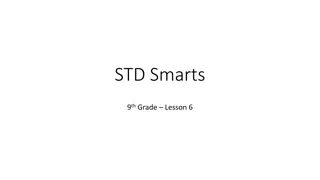Best Practices for Data Standards Design and Implementation
Explore key tips and guidelines for designing, implementing, and minimizing repetition in generic data standards across various data entry guidelines. Dive into detailed examples and descriptions of data standard attributes related to fire acre quantities and final fire perimeter measurements, alongside business rules for accurate reporting. Gain insights into maintaining consistency and precision in data exchange standards.
Download Presentation

Please find below an Image/Link to download the presentation.
The content on the website is provided AS IS for your information and personal use only. It may not be sold, licensed, or shared on other websites without obtaining consent from the author.If you encounter any issues during the download, it is possible that the publisher has removed the file from their server.
You are allowed to download the files provided on this website for personal or commercial use, subject to the condition that they are used lawfully. All files are the property of their respective owners.
The content on the website is provided AS IS for your information and personal use only. It may not be sold, licensed, or shared on other websites without obtaining consent from the author.
E N D
Presentation Transcript
DATA STANDARDS - Tips Generic Data Standards Designators Compound Data Standards Class Words 1
Generic Data Standards Minimize repetition of: Data Exchange Standards and Data Entry Guidelines 2
Data Standard Name: Final Fire Acre Quantity Attribute Name Abbreviation Final Fire Acre Quantity Number of acres within the final fire perimeter of a specific, individual incident, including unburned and unburnable islands. Description Data Exchange Standards Data Entry Guidelines Maximum Length Minimum Length Data Type Case Sensitivity n/a Format Example 11 11 2 2 numeric numeric n/a 9(9).9 111111111.1 9(9).9 111111111.1 1.As a mininum, fires less than one acre will be reported to the tenth of an acre . 2.As a minimum, fires greater than one acre will be reported to the unit acre. 3.For fires that have a fire perimeter mapped in GIS, the final fire size reported should equal the fire size calculated from the GIS perimeter (Fire History polygon), commensurate with the required level of precision. Business Rules Source reference 3
Data Standard Name: Final Fire Acre Quantity Attribute Name Abbreviation Final Fire Acre Quantity Number of acres within the final fire perimeter of a specific, individual incident, including unburned and unburnable islands. Description 1.As a mininum, fires less than one acre will be reported to the tenth of an acre . 2.As a minimum, fires greater than one acre will be reported to the unit acre. 3.For fires that have a fire perimeter mapped in GIS, the final fire size reported should equal the fire size calculated from the GIS perimeter (Fire History polygon), commensurate with the required level of precision. Business Rules Source reference See generic attribute FIRE ACRE QUANTITY for Data Exchange and Data Entry Guidelines. 4
Data Standard Name: Fire Acre Quantity (generic) Attribute Name Abbreviation Description Fire Acre Quantity (generic) The number of fire acres of interest. Data Exchange Standards Data Entry Guidelines Maximum Length Minimum Length Data Type Case Sensitivity n/a Format Example 11 11 2 2 numeric numeric n/a 9(9).9 111111111.1 9(9).9 111111111.1 Final Fire Acre Quantity Daily Fire Acre Quantity Discovery Fire Acre Quantity Initial Response Fire Acre Quantity State And Land Owner Final Fire Acre Quantity etc Attributes using this this Data Standard 5
Data Standard Name: State and Land Owner Final Fire Acre Quantity Attribute Name Abbreviation State and Land Owner Final Fire Acre Quantity Number of acres measured by each Land Owner Kind and Category within a State Code associated with the land within the final fire perimeter of a specific, individual incident. The area measured within the perimeter includes unburned and unburnable islands or portions of such. Description 1.Each instance of final fire acres by land owner and state must be associated with a Land Ownership Category and State Code. 2.Reported to the tenth of an acre for fires less than one acre. 3.Reported to the nearest acre for fires greater than one acre. Business Rules 6
Designators Avoid Use of Designators 7
Designators Frequency Use Designator Data Standard (Frequency Use Name and Description) Name: Description: Tactical Intra-division ground communications within the incident operations area. Initial Fire Strategy Designator Data Standard (Initial Fire Strategy Designator Code and Name) Code: Name: RX Prescribed Fire. (Management Complexity Level Name and Description) Name: Description: Management Complexity Level Designator Data Standard Type 1 Incident Highest management level utilized during the wildfire event is Type 1 (Special Land Designator Name and Description) Name: Description: Special Land Designator Data Standard Nuclear Reservation Officially designated as a Nuclear Reservation or other Department of Energy restricted sites. 8
Compound Data Standards Fire Cause Kind & Category 9
Fire Cause Kind & Category (6 Attributes/Elements) Fire Cause Kind: Fire Cause Category: Fire Cause Kind Code (N) Fire Cause Category Code (V) Fire Cause Kind Name (Natural) Fire Cause Category Name (Volcanic) Fire Cause Kind Description (A fire that occurs without direct or indirect human intervention or action.) Fire Cause Category Description (A fire caused by volcanic activity.) 10
Fire Cause Kind & Category (6 Attributes/Elements) 11
Class Words Examples: Identifier Code Name Description Amount Quantity Address Date Time Indicator Number Text (etc.) 12
Class Words Every attribute/element name should end with a class Word: Employment Category Data Standard Attribute Name: Employment Category (Name) Example: Career Attribute Name: Employment Category (Description) Example: An appointment/agreement that meets the following conditions: Employing office is a government entity; Employees are permanent employees; Year-round work schedule; Employee receives compensation for work. 13
QUESTIONS? 14























